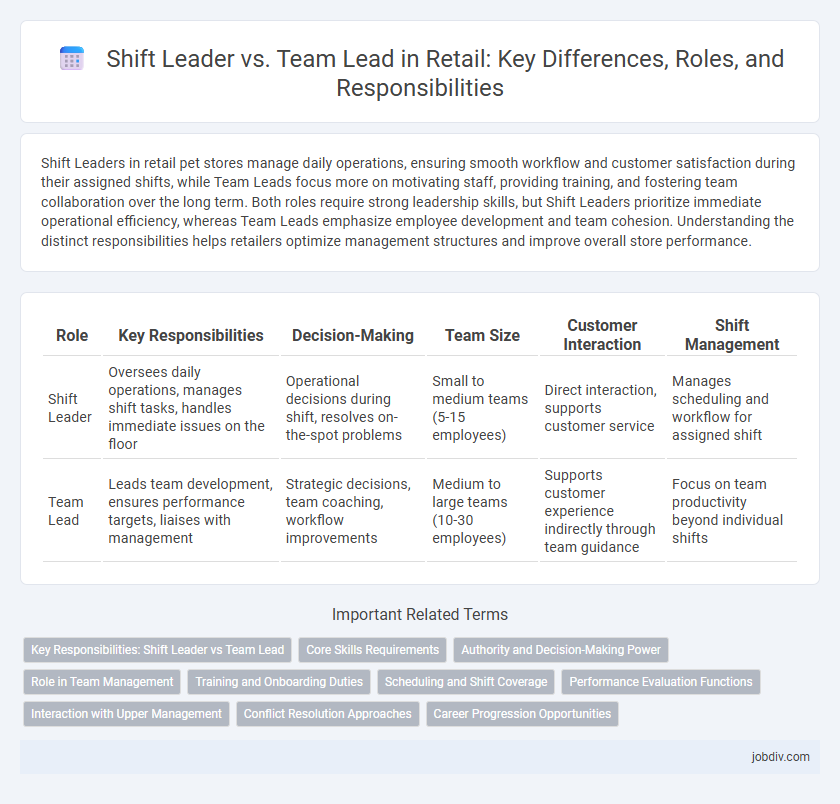Shift Leaders in retail pet stores manage daily operations, ensuring smooth workflow and customer satisfaction during their assigned shifts, while Team Leads focus more on motivating staff, providing training, and fostering team collaboration over the long term. Both roles require strong leadership skills, but Shift Leaders prioritize immediate operational efficiency, whereas Team Leads emphasize employee development and team cohesion. Understanding the distinct responsibilities helps retailers optimize management structures and improve overall store performance.
Table of Comparison
| Role | Key Responsibilities | Decision-Making | Team Size | Customer Interaction | Shift Management |
|---|---|---|---|---|---|
| Shift Leader | Oversees daily operations, manages shift tasks, handles immediate issues on the floor | Operational decisions during shift, resolves on-the-spot problems | Small to medium teams (5-15 employees) | Direct interaction, supports customer service | Manages scheduling and workflow for assigned shift |
| Team Lead | Leads team development, ensures performance targets, liaises with management | Strategic decisions, team coaching, workflow improvements | Medium to large teams (10-30 employees) | Supports customer experience indirectly through team guidance | Focus on team productivity beyond individual shifts |
Key Responsibilities: Shift Leader vs Team Lead
Shift Leaders in retail primarily oversee daily operations during their assigned shifts, managing employee schedules, ensuring inventory accuracy, and addressing immediate customer service issues to maintain smooth workflow. Team Leads focus more on long-term team development, coaching staff, setting performance goals, and facilitating communication between management and front-line employees. Both roles require strong leadership and problem-solving skills but differ in scope, with Shift Leaders handling tactical execution and Team Leads emphasizing strategic team growth.
Core Skills Requirements
Shift Leaders in retail excel in operational management, including scheduling, inventory oversight, and ensuring compliance with safety standards. Team Leads emphasize interpersonal skills, coaching, and conflict resolution to foster team cohesion and drive performance. Both roles require strong communication, problem-solving abilities, and a deep understanding of store processes to maintain efficiency and customer satisfaction.
Authority and Decision-Making Power
Shift leaders in retail have direct authority over daily operations and real-time decision-making on the sales floor, focusing on immediate issue resolution and staff coordination during their shift. Team leads hold broader responsibility, including strategic planning, team performance evaluation, and implementing company policies, often influencing long-term operational decisions. The shift leader's authority is more task-oriented and time-specific, while the team lead exercises greater influence over personnel development and overall team direction.
Role in Team Management
Shift Leaders in retail oversee daily store operations, ensuring team adherence to schedules and quality standards while directly managing frontline employees during shifts. Team Leads focus on developing team skills, providing ongoing training, and fostering collaboration to achieve long-term productivity goals. Both roles require strong communication and leadership but differ in scope, with Shift Leaders prioritizing operational control and Team Leads emphasizing team development.
Training and Onboarding Duties
Shift Leaders in retail are primarily responsible for overseeing employee training during shifts, ensuring that new hires adhere to store policies and customer service standards in real-time. Team Leads play a crucial role in comprehensive onboarding by facilitating initial training sessions, mentoring new team members, and coordinating ongoing development programs to improve overall staff performance. Both positions collaborate to maintain consistent training quality, but Team Leads focus more on structured learning, while Shift Leaders emphasize hands-on guidance during daily operations.
Scheduling and Shift Coverage
Shift Leaders in retail typically manage real-time scheduling adjustments and ensure immediate shift coverage requirements are met to maintain store operations. Team Leads often handle broader scheduling tasks, including planning future shifts and coordinating availability across multiple employees to optimize workforce distribution. Both roles are essential for seamless shift coverage but differ in scope, with Shift Leaders focusing on day-to-day execution and Team Leads on strategic scheduling.
Performance Evaluation Functions
Shift Leaders oversee daily retail operations to ensure smooth workflow and immediate issue resolution, focusing on real-time performance metrics such as sales targets and customer service standards. Team Leads concentrate on broader team development, coaching, and long-term performance improvements through regular evaluations, training feedback, and productivity analysis. Both roles utilize performance evaluation tools, but Shift Leaders emphasize operational execution while Team Leads prioritize employee growth and team cohesion.
Interaction with Upper Management
Shift Leaders in retail primarily manage day-to-day operations and communicate frontline challenges directly to upper management, ensuring immediate issues are addressed efficiently. Team Leads engage in strategic discussions with higher management, bridging the gap between company objectives and team execution by providing feedback and aligning goals. Interaction frequency and depth with upper management are greater for Team Leads due to their broader oversight and responsibility for driving performance improvements.
Conflict Resolution Approaches
Shift Leaders in retail focus on immediate conflict resolution through direct communication and quick decision-making to maintain workflow during shifts. Team Leads employ collaborative conflict resolution strategies by facilitating team discussions and encouraging consensus to foster long-term workplace harmony. Both roles prioritize addressing employee disputes promptly but differ in scope, with Shift Leaders managing on-the-spot issues and Team Leads emphasizing team cohesion and sustained conflict management.
Career Progression Opportunities
Shift Leaders in retail often serve as the initial step into management, gaining hands-on experience in overseeing daily store operations and team coordination. Team Leads typically hold broader responsibilities, including strategic task delegation and performance evaluation, positioning them for higher supervisory roles such as Assistant Manager or Store Manager. Career progression from Shift Leader to Team Lead enhances leadership skills, operational expertise, and prepares individuals for advanced managerial careers within the retail sector.
Shift Leader vs Team Lead Infographic

 jobdiv.com
jobdiv.com